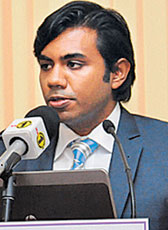'Lanka needs national road map for innovation'
Despite efforts to boost economic growth the focus on science,
technology and innovation is inadequate. The gross expenditure on
research is less than one percent. The expenditure on research and
development by the private sector is remarkably low, Lakshman Kadirgamar
Institute for International Relations and Strategic Studies, Executive
(LKIIRSS) Director Asanga Abeyagoonesekera told a seminar on 'Unleash
your Mind for Tomorrow: Spurring the growth of innovation in Sri Lanka'
organised by LKIIRSS.
 |
|
LKIIRSS Director
Asanga Abeyagoonesekera |
He said the share of high-tech exports out of total manufactured
exports averages less than 2% each year, since the last decade.
Following the end of terrorism in May 2009, the government is on the
drive towards accelerated economic development. If Sri Lanka is to
double its per capita GDP growth by 2015, advancement in science and
technology, and innovation is fundamentally important.
Inventors
"This year, during my work as a Young Global Leader for the World
Economic Forum, I travelled to Davos, and to many other important fora
around the world.
I met and interacted with some amazing inventors and entrepreneurs
such as Tim Burners Lee, the inventor of World Wide Web and Prof.
Jeanette Wing who sequenced the human genome, Bill Gates and Marissa
Mayer of Yahoo.
"The themes for many of these conferences were focused on innovation.
The last conference in China was on Meeting the Innovation Imperative.
With staggering population growth and complex problems emerging around
the world we are all on a serious mission for innovative tools to
improve our lives, with our limited resources," he said.
Sri Lanka was ranked 98 among 142 countries in the Global Innovation
Index 2013. Another important report was the WEF-INSEAD Global
Information Technology Report 2013 Networked Readiness Index (NRI) which
measures the preparedness of an economy to use ICT to boost
competitiveness and well-being.
The Nordic countries and the Asian tigers are at the top of the list.
Finland (first), Singapore (second) and Sweden (third) continue to lead
the NRI, with the Netherlands (fourth), Norway (fifth), Switzerland
(sixth), the United Kingdom (seventh), Denmark (eighth), the United
States (ninth) and Taiwan, China (10th) completing the top 10, while Sri
Lanka is at the 69th place.
Nine variables
The report said, "Despite rapid adoption of mobile telephony, most
developing economies lag behind advanced economies due to environments
that are not conducive for innovation and competitiveness".
One of the sub index drivers is the 'innovation environment pillar'.
It includes nine variables in the ease of doing business index. Red
tape, conditions that allow innovation to flourish, innovative products,
and availability of VC for financing innovation related projects are
some of the variables.
He said that it is important that we improve these areas to improve
our global ranking.
According to Prof. Klaus Schwab, founder of the World Economic Forum
"the traditional distinction between countries being 'developed' or
'less developed' will gradually disappear and we will instead refer to
them much more in terms of being 'innovation rich' versus 'innovation
poor' countries.
It is vital that leaders from business, government and civil society
work together to create education systems and environments which foster
innovation".
Many models
Innovation cannot succeed in isolation. A successful innovation
system connects and brings together various actors - public and private
organisations. It requires the inputs of technical, commercial and
financial expertise.
"There are many models around the world such as Silicon Valley or the
Israel model Wertheimer industry parks created in 1967, from which we
can learn. But we should develop our own model. Building an innovation
culture is important because I think we already had this back then.
"Some 2,500 years ago, Sri Lanka had beenan innovative country.
Irrigation systems found in our ancient kingdoms astonishes modern
engineers. However, innovation has been given low priority in Sri Lanka
over the past several decades unlike most developed and developing
countries where science and technology, and research and development are
given the highest priority.
"Long-term investment in R and D is essential rather than short-term
quick gains. We should work to create a knowledge hub.
Small nation
"Israel, though a small nation, has the world's highest patents and
the highest expenditure on R and D, which is around 4.5%. We could
achieve far greater heights.
"As a computer science student I looked at Israel's Intel Haifa plant
with much interest. When Intel Santa Clara plant couldn't figure out
many problems such as increasing clock speed it was the Haifa plant
which came out with solutions.
"They introduced the design of the first IBM 8088 chipset which paved
way for a new era of computing followed by Intel Centrino, Core 2 duo
chips and dual core processing architectures with increased
microprocessor speed.
"These innovations paved way not for an incremental change but rather
created a revolutionary leap in the industry. You find on your computer,
'Intel inside' and I think it should be 'Israel inside'.
|

